
Blood sugar control is crucial for managing diabetes. This article, What to Eat for Blood Sugar Control: A US Guide, provides a comprehensive guide on what to eat for blood sugar control. It covers topics such as the role of carbohydrates, the importance of fiber-rich foods, and the benefits of specific nutrients like fatty fish and garlic. Additionally, it shares insights on hydration and making informed food choices. With practical tips and meal planning suggestions, this article aims to help individuals achieve successful blood sugar control.
🔍 Seeking a breakthrough in Type 2 Diabetes management?
Discover our expert insights and innovative approaches on ‘How to Cure Diabetes’.
Click to transform your health journey today!

What you\'ll find in this article?
- The Importance of Blood Sugar Control for Diabetes Management - What to Eat for Blood Sugar Control: A US Guide
- Managing Blood Sugar Levels through a Healthy Diet - What to Eat for Blood Sugar Control: A US Guide
- Understanding the Role of Carbohydrates in Blood Sugar Control - What to Eat for Blood Sugar Control: A US Guide
- Incorporating Fiber-Rich Foods for Blood Sugar Regulation - What to Eat for Blood Sugar Control: A US Guide
- The Role of Fatty Fish in Lowering Blood Sugar and Reducing Risks - What to Eat for Blood Sugar Control: A US Guide
- Nutritional Powerhouses for Blood Sugar Control - What to Eat for Blood Sugar Control: A US Guide
- Yogurt and Dairy Products: Balancing Blood Sugar and Boosting Health - What to Eat for Blood Sugar Control: A US Guide
- Hydration and Blood Sugar Control: Choosing the Right Beverages - What to Eat for Blood Sugar Control: A US Guide
- Healthy Eating Habits for a Balanced Blood Sugar Lifestyle - What to Eat for Blood Sugar Control: A US Guide
- Putting It All Together: Practical Tips for Successful Blood Sugar Control - What to Eat for Blood Sugar Control: A US Guide
The Importance of Blood Sugar Control for Diabetes Management - What to Eat for Blood Sugar Control: A US Guide
Blood sugar control plays a crucial role in effectively managing diabetes. By keeping blood sugar levels within a healthy range, individuals can reduce the risk of complications and improve overall well-being.
Achieving blood sugar control requires maintaining a balanced and nutritious diet, along with appropriate lifestyle choices. It's important to prioritize the consumption of foods that help regulate blood sugar levels and provide essential nutrients.
Proper blood sugar control not only helps in preventing hyperglycemia (high blood sugar) but also lowers the risk of hypoglycemia (low blood sugar). Consistently elevated blood sugar levels can lead to serious health issues, such as cardiovascular problems, nerve damage, and kidney disease.
By following a healthy diet for blood sugar control, individuals can better manage their diabetes and improve their overall health. This involves selecting foods that have a low glycemic index and are rich in fiber, nutrients, and antioxidants.
Regular blood sugar monitoring and collaborating with healthcare professionals are also essential for effective diabetes management. By understanding the importance of blood sugar control and making informed choices regarding diet and lifestyle, individuals can take control of their diabetes and lead a healthier life.
Explore our specialized services in diabetes care 🌟.
From personalized diet plans to effective exercise routines, we have what you need to take control of Type 2 Diabetes.
Visit our services page now!







Managing Blood Sugar Levels through a Healthy Diet - What to Eat for Blood Sugar Control: A US Guide
Achieving and maintaining healthy blood sugar levels is crucial for individuals managing diabetes. A balanced and nutritious diet plays a vital role in this process. By making smart food choices, you can effectively manage your blood sugar levels and enhance your overall well-being.
Understanding the Role of Carbohydrates in Blood Sugar Control
Carbohydrates have a direct impact on blood sugar levels, so it's essential to choose the right ones. Opt for complex carbohydrates found in whole grains, vegetables, and fruits, as they are digested slowly, leading to a more gradual rise in blood sugar. These foods also provide essential nutrients, vitamins, and minerals.
Choosing the Right Carbohydrates
When managing blood sugar levels, focus on selecting carbohydrates with a low glycemic index (GI). This means opting for whole grains, legumes, and colorful vegetables, as they have a lower impact on blood sugar compared to refined carbohydrates like white bread or sugary snacks.
Whole Grains: A Smart Choice for Blood Sugar Control
Incorporate whole grains such as quinoa, brown rice, and oats into your diet. These grains contain beneficial fiber that helps regulate blood sugar levels and provide sustained energy throughout the day.
Incorporating Fiber-Rich Foods for Blood Sugar Regulation
Fiber-rich foods not only promote healthy digestion but also help regulate blood sugar levels. Fruits, vegetables, legumes, and whole grains are excellent sources of fiber. Aim to include a variety of these foods in your daily meals to maintain stable blood sugar levels.
Benefits of Soluble Fiber in Blood Sugar Management
Foods rich in soluble fiber, such as apples, citrus fruits, and oats, can have a positive impact on blood sugar regulation. Soluble fiber absorbs water and forms a gel-like substance in the digestive system, slowing down the absorption of sugar into the bloodstream.
Fruits and Vegetables: Fiber Powerhouses for Blood Sugar Control
Include a colorful array of fruits and vegetables in your diet. These nutrient-packed foods are not only rich in fiber but also provide essential vitamins, minerals, and antioxidants that support overall health and blood sugar control.
Understanding the Role of Carbohydrates in Blood Sugar Control - What to Eat for Blood Sugar Control: A US Guide

Carbohydrates play a crucial role in managing blood sugar levels effectively. By choosing the right carbohydrates, individuals can maintain stable blood sugar levels and support their overall health.
Choosing the Right Carbohydrates
When it comes to carbohydrates, not all are created equal. Opting for complex carbohydrates, such as whole grains, legumes, and fruits, can provide sustained energy and help regulate blood sugar levels. These carbohydrates are digested slowly, preventing sudden spikes in blood sugar.
Whole Grains: A Smart Choice for Blood Sugar Control
Whole grains, such as brown rice, quinoa, and whole wheat bread, are excellent choices for blood sugar control. They are rich in fiber, vitamins, and minerals, which promote satiety and regulate the absorption of sugar into the bloodstream. Including whole grains in meals can help individuals maintain stable blood sugar levels.
Additionally, whole grains offer various health benefits, including reduced risk of heart disease, improved digestion, and weight management. They are versatile and can be incorporated into breakfast cereals, salads, main dishes, or side dishes.
- Choose whole grain bread instead of white bread
- Opt for brown rice instead of white rice
- Include quinoa in salads or as a side dish
By making these simple substitutions, individuals can make significant strides in managing their blood sugar levels effectively.
Incorporating Fiber-Rich Foods for Blood Sugar Regulation - What to Eat for Blood Sugar Control: A US Guide
Fiber is a crucial component in managing blood sugar levels effectively. It not only adds bulk to your diet but also helps slow down the absorption of sugar into your bloodstream, promoting stable blood sugar levels. Additionally, fiber-rich foods offer a range of other health benefits, including improved digestion and heart health.
Benefits of Soluble Fiber in Blood Sugar Management
Soluble fiber plays a key role in blood sugar regulation as it forms a gel-like substance in your digestive system. This gel slows down the digestion and absorption of carbohydrates, leading to a more gradual increase in blood sugar levels. Soluble fiber also aids in satiety, helping you feel fuller for longer periods and potentially preventing overeating.
Fruits and Vegetables: Fiber Powerhouses for Blood Sugar Control
- Include a variety of fruits and vegetables in your diet as they are rich in both soluble and insoluble fiber.
- Colorful options like berries, citrus fruits, leafy greens, and cruciferous vegetables are particularly beneficial.
- Opt for whole fruits instead of fruit juices to ensure you're getting the natural fiber content.
- Consider snacking on raw vegetables or adding them to your meals for an extra fiber boost.
By incorporating fiber-rich foods into your meals and snacks, you can support better blood sugar control and overall health. Remember to stay hydrated and make informed food choices that align with your specific dietary needs and preferences.
The Role of Fatty Fish in Lowering Blood Sugar and Reducing Risks - What to Eat for Blood Sugar Control: A US Guide
Fatty fish, such as salmon, trout, and sardines, play a significant role in managing blood sugar levels and reducing the risks associated with diabetes. These fish varieties are rich in omega-3 fatty acids, which have been found to improve insulin sensitivity and reduce inflammation in the body.
The omega-3 fatty acids found in fatty fish can also help lower triglyceride levels, a type of fat that can be elevated in individuals with diabetes. By reducing triglyceride levels, fatty fish helps to maintain a healthy cardiovascular system, reducing the risk of heart disease, a common complication of diabetes.
Incorporating fatty fish into your diet is easy. You can enjoy grilled salmon as a main course, toss some trout in your salad, or include sardines in a delicious sandwich. Aim to include fatty fish in your meals at least twice a week to reap the maximum benefits.
Keep in mind that cooking methods matter when it comes to maintaining the health benefits of fatty fish. Opt for baking, grilling, or steaming instead of frying to avoid adding unnecessary unhealthy fats to your meal.
Adding fatty fish to your diet not only provides essential nutrients but also supports blood sugar control and reduces health risks associated with diabetes. So, make it a point to include these fish varieties in your weekly meal plan for a healthier and happier you.
Nutritional Powerhouses for Blood Sugar Control - What to Eat for Blood Sugar Control: A US Guide
Nutrition plays a crucial role in managing blood sugar levels and promoting optimal health. Incorporating certain foods into your diet can provide a significant impact on blood sugar control. Here are two key components:
Nuts, Legumes, and Beans: Excellent Sources of Fiber and Protein
- Nuts, such as almonds, walnuts, and pistachios, are not only rich in healthy fats but also provide fiber and protein. They have a low glycemic index, which means they have a minimal impact on blood sugar levels.
- Legumes, including lentils, chickpeas, and black beans, are high in fiber and protein. They help slow down the digestion process, preventing spikes in blood sugar levels.
- Beans, such as kidney beans, pinto beans, and navy beans, contain a combination of fiber and protein. They offer a steady release of glucose into the bloodstream, promoting stable blood sugar levels.
The Power of Garlic in Blood Sugar Regulation
Incorporating garlic into your meals not only adds flavor but also provides potential benefits for blood sugar control:
- Garlic contains sulfur compounds that have been shown to improve insulin sensitivity, helping your body effectively utilize glucose.
- Research suggests that garlic may contribute to lower fasting blood sugar levels and offer potential cardiovascular benefits for individuals with diabetes.
- Whether consumed fresh, roasted, or as a seasoning in various dishes, garlic can be a valuable addition to your diet for blood sugar regulation.
By including these nutritional powerhouses - nuts, legumes, beans, and garlic - in your diet, you can support stable blood sugar levels and overall health.
Yogurt and Dairy Products: Balancing Blood Sugar and Boosting Health - What to Eat for Blood Sugar Control: A US Guide
Yogurt and dairy products are not only delicious but also play a crucial role in balancing blood sugar levels and promoting overall health. These dairy options provide essential nutrients, including protein, calcium, and vitamin D, while offering various benefits for blood sugar control.
When selecting yogurt, opt for plain, unsweetened varieties without added sugars. Greek yogurt, in particular, is a great choice as it contains higher protein content and is lower in carbohydrates. The proteins in yogurt help slow down the digestion of sugars, preventing rapid spikes in blood sugar levels.
Not only does yogurt offer a low glycemic index, but it can also improve insulin sensitivity and reduce insulin resistance. This makes it an excellent option for individuals looking to manage their blood sugar levels effectively.
Incorporating dairy products, such as cheese or milk, can also be beneficial, given they are consumed in moderation. However, it is important to choose low-fat or part-skim versions to minimize saturated fat intake.
Remember to read food labels carefully and opt for products that are free from added sugars. Adding yogurt and dairy products to your diet can be a delicious way to maintain stable blood sugar levels while enjoying the numerous health benefits they provide.
Hydration and Blood Sugar Control: Choosing the Right Beverages - What to Eat for Blood Sugar Control: A US Guide

Proper hydration is essential for managing blood sugar levels effectively. When selecting beverages, it's important to opt for options that won't cause spikes in blood sugar. Here are some key choices to consider:
Water: The Ultimate Zero-Sugar Drink for Blood Sugar Management
Stay hydrated with the most natural and zero-calorie drink available – water. It does not contain any sugars or artificial additives, making it an ideal choice for maintaining stable blood sugar levels.
Tea and Coffee: Sugar-Free Alternatives for Sugar Control
If you enjoy a warm beverage, opt for unsweetened tea or coffee. These drinks have minimal to zero sugar content and can be enjoyed plain or with a natural sugar substitute like stevia. Just be mindful of the caffeine content and choose decaffeinated options if necessary.
Zero-Sugar Carbonated Drinks: A Refreshing Option for Blood Sugar Control
For those who crave carbonation, zero-sugar carbonated drinks are a great choice. Look for options that are free from added sugars and artificial sweeteners. These fizzy drinks can provide a refreshing experience without impacting blood sugar levels. Remember, it's crucial to read labels and avoid sugary beverages, fruit juices, energy drinks, and alcoholic beverages that contain added sugars or mixers. By making smart beverage choices like opting for water, unsweetened tea or coffee, and zero-sugar carbonated drinks, you can maintain proper hydration while supporting your blood sugar control efforts. Note: Always consult a healthcare professional or registered dietitian for personalized advice regarding individual dietary needs and blood sugar management strategies.
This article was last updated on October 9, 2023.
Healthy Eating Habits for a Balanced Blood Sugar Lifestyle - What to Eat for Blood Sugar Control: A US Guide
Maintaining healthy eating habits is crucial for managing blood sugar levels and achieving a balanced lifestyle. By making informed food choices, practicing portion control, and incorporating exercise into your routine, you can effectively control your blood sugar and promote overall well-being.
Making Informed Food Choices for Blood Sugar Management
When it comes to managing blood sugar, it's important to choose foods that have a low glycemic index and provide essential nutrients. Some smart food choices include whole grains, fresh fruits and vegetables, lean proteins, and healthy fats like avocados and nuts. These options offer sustained energy and help prevent sharp spikes in blood sugar levels.
Understanding Portion Control and Meal Planning
Practicing portion control plays a significant role in blood sugar management. By measuring your food and paying attention to serving sizes, you can avoid overeating and maintain a balanced intake of carbohydrates and other nutrients. Additionally, creating a meal plan that includes a variety of nutritious foods can aid in effective blood sugar control throughout the day.
The Combined Benefits of Diet and Exercise for Blood Sugar Control
Incorporating regular exercise into your routine can complement a healthy diet and promote blood sugar control. Engaging in physical activities like walking, cycling, or strength training can improve insulin sensitivity, help regulate blood sugar levels, and support overall cardiovascular health.
By adopting healthy eating habits, focusing on portion control, and combining it with regular exercise, you can effectively manage your blood sugar levels and lead a balanced lifestyle that promotes overall well-being and diabetes management.
- Choose foods with a low glycemic index and essential nutrients
- Practice portion control and mindful eating
- Create a meal plan with a variety of nutritious foods
- Incorporate regular exercise into your routine
Putting It All Together: Practical Tips for Successful Blood Sugar Control - What to Eat for Blood Sugar Control: A US Guide
To effectively manage blood sugar levels and maintain a healthy lifestyle, here are some practical tips:
- Make balanced food choices: Opt for a variety of nutrient-rich foods, including lean proteins, whole grains, fruits, and vegetables. Avoid excessive consumption of refined grains, sugary snacks, and processed foods.
- Monitor portion sizes: Keep an eye on serving sizes to avoid overeating. Use smaller plates and bowls to control portions and listen to your body's hunger and fullness cues.
- Plan meals in advance: Prepare a weekly meal plan to ensure a well-balanced diet. Include foods with low glycemic index values and aim for a combination of complex carbohydrates, healthy fats, and protein in each meal.
- Stay active: Engage in regular physical activity to help regulate blood sugar levels. Find activities you enjoy, such as walking, cycling, or dancing, and aim for at least 150 minutes of moderate-intensity exercise per week.
- Manage stress: Find healthy ways to cope with stress, as it can affect blood sugar levels. Try relaxation techniques like deep breathing, yoga, or mindfulness meditation.
- Stay hydrated: Drink plenty of water throughout the day to maintain proper hydration. Limit your intake of sugary beverages, as they can cause blood sugar spikes.
- Get enough sleep: Prioritize quality sleep to support overall health and blood sugar control. Aim for 7-9 hours of uninterrupted sleep each night.
- Track your progress: Regularly monitor your blood sugar levels and keep a record of your meals, exercise, and any relevant adjustments. Consult with a healthcare professional or registered dietitian for personalized guidance.
By adopting these practical tips into your daily routine, you can have better control over your blood sugar levels and lead a healthier, more balanced life.
✨ Other articles you might be interested in:



